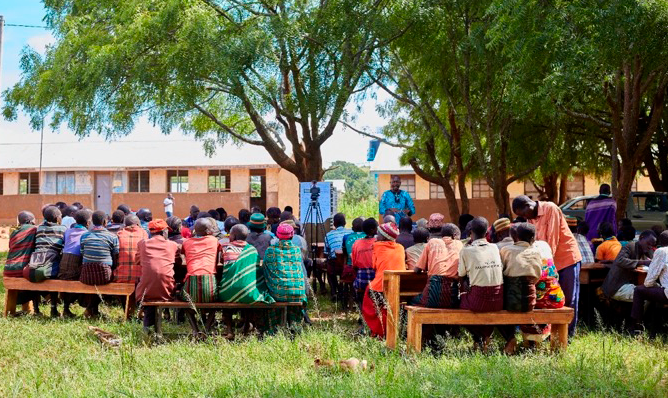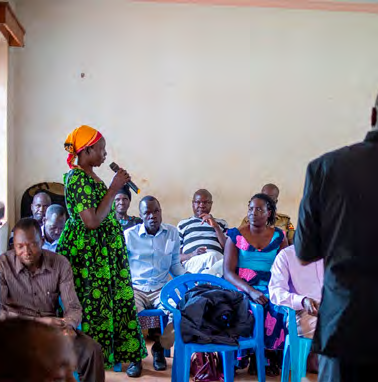In Uganda, a devolved climate finance mechanism is enabling local leadership
Devolve decision making
Patient, predictable, accessible funding
Collaborative action and investment
Photo credit: MWE-LIFEAR
In December 2019 at COP25 in Madrid, the LDC Group called on development partners to sign up to a partnership called the LDC Initiative for Effective Adaptation and Resilience (LIFE-AR). The UK was among 14 government signatories committing, amongst other things, to:
Provide high-quality, predictable, and accessible finance to help deliver the Sustainable Development Goals and the Paris Agreement.
Support the LDCs in their intention to ensure that at least 70% of the climate finance they receive flows to the local level by 2030.
Work together to reduce transaction costs and ensure mutual accountability.
Work together to strengthen national and local institutional capabilities in LDCs.
A few months later, in April 2020, the UK agreed to provide modest initial funding to create the LIFE-AR initiative. The UK’s Foreign, Commonwealth and Development Office (FCDO) will continue to support the LIFE-AR initiative through to 2028, providing predictable funding over an eight year timeframe. The US and Canada joined the UK and Ireland to contribute to the initiative. LIFE-AR is presently managed by the International Institute for Environment and Development (IIED), but will come under full LDC management by 2026.

Community awareness meeting in Kaabong District
Uganda started work on the LIFE-AR initiative in 2020. A two-year establishment phase focused on establishing a sustainable framework for long-term implementation including a national platform for governance — with representation from relevant ministries, departments, agencies, civil society representatives, and academia. Following widespread consultations, a national Devolved Climate Finance (DCF) Mechanism was established, along with a framework for monitoring, evaluation, and learning. The DCF Mechanism was designed by a technical working group with representation from local governments to align with the country’s decentralized governance structure. The working group proposed establishing Parish Climate Change Committees (PCCCs) at the parish level, Uganda’s smallest administrative unit.
The mechanism was piloted in 12 districts across Uganda’s four water management zones, selected based on their vulnerability to climate hazards. Following capacity needs assessments at the district, sub-county, and parish levels — and the development of DCF operational guidelines and training materials — the mechanism was implemented in a phased approach across four pilot districts.
Capacity-Strengthening Phase
A Training of Trainers approach was implemented to equip technical staff in the pilot districts with the skills they needed to roll out the DCF mechanism. This brought together national and district actors to reflect on the operational challenges, opportunities, and complexities of working within Uganda’s decentralized governance system.
“I appreciate the transparency in how this project is managed. Decisions are left to the communities, without any top-down dictation, allowing them to identify their own climate resilience challenges and solutions.”
- Seydou Adolatona Opoka, District Production Officer, Pader
The training was also an opportunity to question existing practices. “Often, we focus too much on monitoring and evaluation but overlook learning,” said Muhammad Semambo, principal climate change officer in the Ministry of Water and Environment, Climate Change Department. “Yet, it’s through learning that we can identify best practices and improve.”

Implementation Phase
As part of the implementation phase, which started in May 2024, technical staff and political leaders from the districts were invited to take part in awareness campaigns about the initiative’s objectives and processes. They selected which sub-counties and parishes to target, and raised awareness through radio, megaphones, and meetings. Existing government structures were strengthened, and new ones, like the PCCCs, were established where necessary.
“You brought the planning to us to ensure the community takes the lead,” said Ocen Willy, a parish councilor in Pader. “To avoid bias and ensure transparency in selecting local leaders, let us have a transparent voting process for the parish committee.”
“In the last two years, the district has suffered massive crop and livestock losses due to droughts and floods,” said Captain Chris Mike Okiya, resident district commissioner of Kaabong, located in the semi-arid region of Karamoja, which is repeatedly impacted by climate extremes. “The way LIFE-AR is designed is unique as it puts communities at the center of making decisions on projects that are going to help them deal with these challenges. We must ensure strong community engagement and local leadership to ensure the program is owned at every level and delivers real change.”
“As an agricultural district, climate change affects our livelihoods directly,” said George Owile, district planner, Kibaale. “LIFE-AR is a blessing because it provides the resources we need to mobilize and engage communities. We will use a multimedia approach to create awareness about the project through community meetings, radio programs, and other methods (for example, church gatherings) but also talking to our community leaders at sub-county and parish level. We hope that through LIFE-AR we can work together with all stakeholders including women, youth, and people with disabilities to improve livelihoods and avert poverty in our communities.
Gender-Based Challenges
Existing gender equity challenges surfaced in a community awareness raising meeting. “As women of Kiti village, we cultivate our coffee alongside our husbands,” said a resident of Kassunga Parish in Kalungu District. “We suffer with the work to get the best yields. But when the selling time comes, our husbands exclude us… They sell the coffee without consulting us and use the money to marry other women. Despite our involvement in the harvesting, drying, and packaging, we’re not given access to the money.”
The need for gender balance is clearly articulated in the DCF implementation guidelines. The DCF mechanism also includes a toolkit to help identify how climate priorities differ for men, women, and young people — allowing each group to articulate their livelihood strategies and preferences in response to climate risks.
Next up for the initiative in Uganda is building the capacities of PCCCs to work with communities. The focus is on identifying local solutions to climate challenges, and establishing effective monitoring, reporting, and accountability processes — together. Lessons from the pilot districts will also guide how the initiative expands in new districts.
Uganda’s journey has demonstrated that the process is just as important as the end goal. By working with national experts, the program continues to strengthen existing country systems, processes, and institutions. The focus is on strengthening local institutions instead of creating new ones, and introducing new ones only where gaps exist. The long-term success of LIFE-AR will depend on sustained, multi-year funding from committed funders — alongside leadership from those who are most impacted